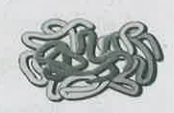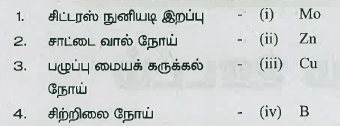கூற்று (A) : தைலக்காய்டுகளின் உள் இடைவெளியில் அதிகரிக்கும் பு£ராட்டான் செறிவானது ATP உற்பத்திக்கு காரணமாக உள்ளது. காரணங்கள் (B) : PSI-இல் காணப்படும் ஆக்ஸிஜன் வெளி6யற்றம் கூட்டமைப்பு தைலகாய்டு உறையின் மீது ஸ்ட்ரோமாவை நோக்கி காணப்படுவதுடன் H+அயனிகளை வெளியேற்றுகிறது.
கூற்று மற்றும் காரணங்கள் சரி
கூற்று சரி, காரணங்கள் தவறு
கூற்று தவறு, காரணங்கள் சரி
கூற்று, காரணங்கள் இரண்டும் தவறு
Topper's Solved these Questions
Similar Questions
கீழ்க்கண்டபடத்திற்குரிய சரியான விடையை தேர்ந்தெடு.

View Solutionபொருத்தமான இணையைத் தேர்ந்தெடு:

View SolutionIf x=φ(t),y=ψ(t),thend2ydx2 is (a)φ′ψ''−ψ'φ''(φ′)2 (b) φ′ψ''−ψ'φ''(φ′)3 (c)φ''ψ'' (d) ψ''φ''
View SolutionIn schrodinger wave equation ∇2ψ+?π2mh2(E−V)ψ=0 ? is- "
View SolutionWhich one of the following conditions is incorrect for a well behaved wave function (ψ) (A) ψ must be finite (B) ψ2 must be single valued (C) ψ must be infinite (D) ψ must be continuous
View SolutionIn chemiosmotic synthesis of ATP, H+ diffuses through ATP-synthetase -
View Solutionகூற்று (A) : தைலக்காய்டுகளின் உள் இடைவெளியில் அதிகரிக்கும் பு£ராட்டான் செறிவானது ATP உற்பத்திக்கு காரணமாக உள்ளது. காரணங்கள் (B) : PSI-இல் காணப்படும் ஆக்ஸிஜன் வெளி6யற்றம் கூட்டமைப்பு தைலகாய்டு உறையின் மீது ஸ்ட்ரோமாவை நோக்கி காணப்படுவதுடன் H+அயனிகளை வெளியேற்றுகிறது.
View Solutionபொருள் எப்பொழுது 'ஓய்வு அல்லது இயக்கத்தில் உள்ளது எனலாம்?
View Solutionकोशिका A एवं कोशिका B निकटस्थ पादप कोशिकाएँ हैं। कोशिका A में, Ψ=-20 बार एवं Ψ=8 बार। कोशिका B में, Ψ=−12 बार एवं Ψ=2 बार, तो
View Solutionप्रक्कथन : स्ट्रोमल थायलेकॉयड PSI तथा PS II दोनों में प्रचुर होता है।
कारण : ग्रेनल झिल्लियाँ (membranes) ATP सिन्थेटेज में प्रचुर होती हैं।
View SolutionIf x=φ(t),y=ψ(t),thend2ydx2 is (a)φ′ψ''−ψ'φ''(φ′)2 (b) φ′ψ''−ψ'φ''(φ′)3 (c)φ''ψ'' (d) ψ''φ''
View SolutionIf x=φ(t),y=ψ(t),thend2ydx2 is φ′ψ−ψ'φ''(φ′)2 (b) φ′ψ−ψ'φ''(φ′)3 φ/ψ (d) ψ/φ
View SolutionIf a=cosθ+isinθ, b=cosϕ+isinϕ, c=cosψ+isinψ and ab+bc+ca=2 then sin(θ−ϕ)+sin(ϕ−ψ)+sin(ψ−θ) equals
View SolutionAccording to chemiosmotic hypothesis, ATP synthetase form ATP when protons (H^+) ,
View SolutionIf x=φ(t),y=ψ(t),thend2ydx2 is (a)φ′ψ''−ψ'φ''(φ′)2 (b) φ′ψ''−ψ'φ''(φ′)3 (c)φ''ψ'' (d) ψ''φ''
View SolutionThe value of (sec psi(1-sin psi)(sin psi+ cos psi)(sec psi+tan psi))/(sin psi(1+tan psi)+cos psi(1+cot psi)) is equal to: (sin psi(1-sin psi)(sin psi+ cos psi)(sec psi+tan psi))/(sin psi(1+tan psi)+cos psi(1+cot psi)) का मान किसके बराबर है?
View Solution
